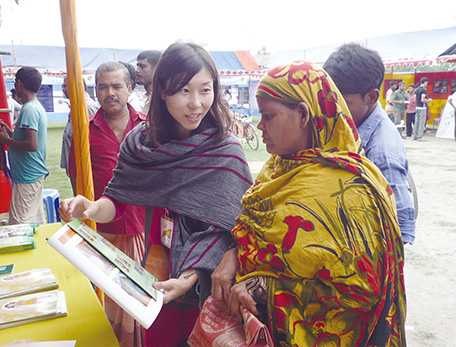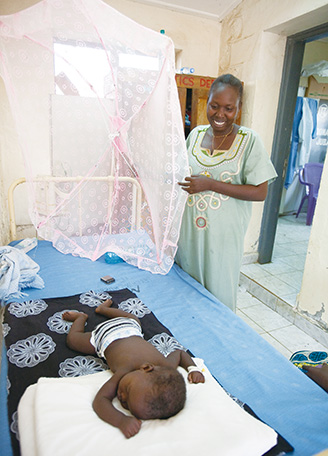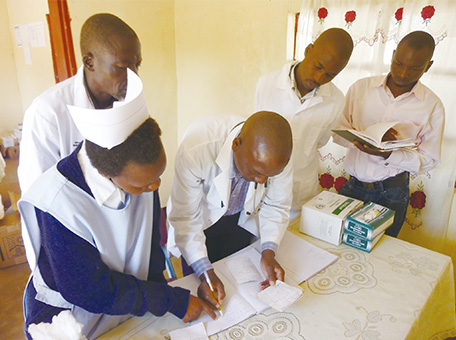Japan's Official Development Assistance White Paper 2013
(2) Infectious Diseases
Infectious diseases such as HIV/AIDS, tuberculosis, and malaria are a major problem that affects not only the health of individuals, but also the socio-economic development of developing countries. In addition, co-infection of HIV/AIDS and tuberculosis, and the emergence of multidrug-resistant and extensively drug-resistant tuberculosis for which conventional drugs are not effective is a significant problem. Further, strengthening measures against new strains of influenza, tuberculosis, malaria, and other emerging and reemerging infectious diseases*, as well as ramping up for the final stage of initiatives to eradicate polio, continue to be international issues.
Moreover, “neglected tropical diseases”* such as Chagas disease, Filariasis, Schistosomiasis have infected approximately 1 billion people worldwide (Note 7), causing major socio-economic loss in developing countries. Because infectious diseases have an impact that crosses national borders, the international community must unite to address them. Japan cooperates closely with the relevant countries and international organizations to implement countermeasures.

A Japan Overseas Cooperation Volunteer explaining about filariasis, an infectious disease, in Bangladesh. (Photo: Chika Yoshida / Embassy of Japan in Bangladesh)
<Japan’s Efforts>
●The three major infectious diseases (HIV/AIDS, tuberculosis, and malaria)
Japan attaches great importance to supporting the fight against these diseases through “the Global Fund to Fight AIDS, Tuberculosis and Malaria (the Global Fund).” Discussions on measures against infectious diseases held for the first time at the G8 Kyushu-Okinawa Summit held in 2000 led to the establishment of the Global Fund as an organization to provide funding against the three major infectious diseases. As one of its founders, Japan has contributed to the Global Fund since its establishment in 2002, and at the MDGs Summit in September 2010, Japan pledged to contribute up to $800 million to the Global Fund in the following years. Japan contributed approximately $1.86 billion to the Global Fund by the end of 2013. It is estimated that support by the Global Fund has saved more than 8.7 million lives. Additionally, Japan is ready to provide supplemental bilateral aid through its own program to developing countries receiving aid from the Global Fund so that measures against these three major infectious diseases can be implemented effectively in those countries. Japan is also striving to strengthen the linkage between the aid from the Global Fund and the improvement of health care systems, community empowerment, and the policies for maternal and child health in those countries.
As HIV/AIDS countermeasures through bilateral assistance, to prevent new infections Japan spreads knowledge, raises awareness, provides testing and counseling, and enhances the distribution of drugs to treat HIV/AIDS. In particular, mainly in Africa, JOCV on HIV/AIDS Control are vigorously engaged in the spread of knowledge and understanding of prevention, and in the care and support of people living with HIV/AIDS.
About tuberculosis, under the Global Plan to Stop TB 2006-2015, Japan has been promoting the implementation of a series of measures against tuberculosis such as the prevention of infection, early detection, diagnosis, and continuous treatment to the countries prioritizing the prevention of tuberculosis that the World Health Organization (WHO) has designated and the countries with high prevalence of tuberculosis, and also the measures against co-infection of HIV/AIDS and tuberculosis. In July 2008, the Ministry of Foreign Affairs (MOFA) and the Ministry of Health, Labour and Welfare (MHLW) announced the “Stop TB Japan Action Plan” that was developed jointly with JICA, the Japan Anti-Tuberculosis Association, and the Stop TB Partnership Japan. Japan would utilize the experience and technology it had fostered through domestic tuberculosis countermeasures domestically, and in collaboration between the public and private sectors, has worked to reduce the number of deaths from tuberculosis by 10% (160,000 people, based on 2006 figures) worldwide, by focusing efforts on reducing such deaths in developing countries, particularly in Asia and Africa. The group revised the Stop TB Japan Action Plan in 2011 in response to WHO’s 2010 revision of the original plan into Global Plan to Stop TB 2011-2015. They confirmed that they would continue to fight tuberculosis on a global level under new international health policies.
Japan assists in efforts to implement measures against malaria, a major cause of infant mortality, by strengthening local communities and through cooperation with the United Nations Children’s Fund (UNICEF).

At a teaching hospital in Juba, South Sudan. Since the effects of malaria are more severe in children, it is vital to provide a mosquito net. (Photo: Shinichi Kuno / JICA)
●Zambia
The Project for Scaling Up of Quality HIV/AIDS Care Service Management
Technical Cooperation Project (November 2009 – Ongoing)
Life expectancy at birth in Zambia — located in inland southern Africa — still remains low at 47 years, which is lower than the life expectancy in Sub-Saharan Africa of 54 years. One of the reasons for this is HIV/AIDS, which affects one in every seven citizens in Zambia. When an individual is infected by HIV, it continues to attack, weaken the immune system and reduce physical strength. While it is impossible to completely remove the virus, taking medication for life prevents the weakening of the immune system, and enables patients to live a normal life and have a relatively long life expectancy.
However, due to the lack of roads, bridges and public transport such as buses to nearby clinics, it is difficult for HIV/AIDS sufferers in rural areas of Zambia to continue taking their medications and receiving treatment.
In these areas, Japan is supporting to help build a system in which local health authorities travel to patients who don’t have access to treatment and administer HIV/AIDS checkups and treatments. Japan is also supporting training for health workers who provide HIV/AIDS treatments and services.
These activities allow 50,000 to 60,000 HIV/AIDS sufferers in rural areas of Zambia to receive treatments, and reduce patients’ travel times and financial burden. It is expected that this support will help HIV/AIDS sufferers who are struggling with the basics of life restore their basic human dignity.
(As of August 2013)

A meeting among local health authority staff (Photo: Shinsuke Miyano / JICA)
Note 7: Source: WHO "Working to overcome the global impact of neglected tropical diseases" (PDF, 2.96MB)![]()
●Polio
Polio is in the final stages of eradication. Japan works mainly with UNICEF to support efforts to eradicate polio chiefly in three polio-endemic countries (countries in which polio was never eradicated and is still spreading), namely Nigeria, Afghanistan and Pakistan. In August 2011, Japan partnered with the private sector’s Gates Foundation through nearly ¥5 billion of ODA loan for providing polio vaccinations to about 32 million Pakistani children under age five. Further, in FY2012, Japan provided a total of approximately ¥1.55 billion for the three polio-endemic countries, as well as over $4.6 million for African countries including Chad and the Democratic Republic of the Congo. In FY2013, Japan also provided ¥110 million to Somalia as an emergency measure.
●Neglected Tropical Diseases (NTDs)
In 1991, Japan took the lead and launched a full-scale effort against Chagas disease, which is known as a “disease of poverty”, in Central America. Japan helped establish a system for dealing with Chagas disease vectors and continues to help reduce the risk of infection. In regard to Filariasis, Japan supplies antiparasitic agents as well as educational materials to provide knowledge and understanding to a large number of people. Japan also conducts preventive education through JOCV in order to reduce the number of new patients and maintain the non-epidemic status.
Furthermore, in April 2013, the Global Health Innovative Technology Fund (GHIT Fund), the first public-private partnership in Japan to facilitate the development of new drugs for treatment of infectious diseases including NTDs in developing countries, was established. While enhancing global linkages with research and development institutions inside and outside Japan, the GHIT Fund aims to defeat infectious diseases in developing countries through the research and development of low-cost and effective therapeutic medicine, vaccines, and diagnostic products. (See this page for more details regarding the GHIT Fund.)
●Vaccinations
It has been proven that vaccines are a cost-effective method for combating infectious diseases, and it is estimated that 2 to 3 million lives could be saved each year with vaccination. (Note 8) In 2011, Japan made its first contribution to the GAVI Alliance (Global Alliance for Vaccines and Immunization)*, which was established in 2000 to improve immunization rate in developing countries, and since then Japan has provided a total of approximately $27.48 million. It has been estimated that since its launch in 2000, the GAVI Alliance has helped save more than 5.5 million lives, and that it will be able to save 4 million more lives from 2011 to 2015, the deadline for achievement of the MDGs.
Glossary
- *Emerging/reemerging infectious diseases
- Emerging diseases: SARS (severe acute respiratory syndrome), avian influenza, the Ebola virus, and other infectious diseases that were not known in the past but that have been newly recognized in recent years.
Reemerging diseases: Cholera, tuberculosis, and other infectious diseases that had spread widely in the past, then subsequently saw a decrease in the number of patients and were believed to have converged, but that have increased again in recent years. - *Neglected tropical diseases
- Chagas disease, dengue fever, filariasis, and other diseases transmitted from parasited, bacteria, etc. The number of infected individuals has reached approximately 1 billion worldwide, with some cases resulting in death, although many of the diseases could be prevented or eradicated. In addition, because of factors such as the prevalence among the poor, there is little public concern, so the development and spread of diagnostic methods, treatment, and new drugs is lagging.
- *GAVI Alliance (Global Alliance for Vaccines and Immunization)
- A public-private partnership that aims to save children’s lives and protect people’s health by increasing access to immunization in developing countries. The GAVI Alliance works together with the governments of member countries, and relevant international organizations, the pharmaceutical industry, private foundations and NGOs.
Note 8: Source: WHO “Health topics, Immunization” http://www.who.int/topics/immunization/en![]()
![]()
